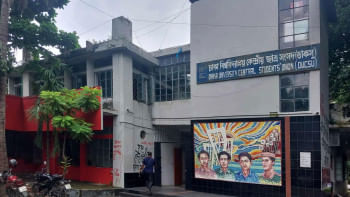Chinese cooperation in health sector

Photo:Zobaer Hossain Sikder
THE joint statement issued by Bangladesh and China on March 19 emphasised closer partnership between the two countries in the areas of trade, agriculture, transportation and infrastructure development. In addition, our prime minister, while addressing Chinese investors, invited them to mobilise their resources and increase energetic efforts in promising sectors like textiles, telecommunications, health, education, small machineries, fertilisers, footwear, power, gas and energy, port development etc, and to participate in the initiatives of the Bangladesh government to achieve its target of vision 2021.
Bangladesh is considered as a land of opportunities for investors due to its unexplored areas of ventures supported by the openness of the government to accommodate foreign investors. One of the most attractive areas is the health, nutrition and population sector, where China can contribute much in terms of investment and traditional wisdom.
China, an ancient civilisation, is used to providing health care services through traditional medicine. Traditional Chinese medicine is based on the concept that the human body is a small universe with complete and sophisticated interconnected systems, and that those systems usually work in balance to maintain the function of the body. This system could be kept in order with the application of traditional herbs, dried plants and animal parts like dried snake, turtle plastron, shark fin soup and dried sea horses, and by maintaining balanced diet, using water therapy etc.
Traditional Chinese practitioners believe that diagnostic methods should concentrate on intense observation, understanding of aliments, hearing, smelling, touching, pulse reading, and acupuncture. Acupuncture, dietary therapy, shiatsu massage are so popular that many Bangladeshis went to China to learn the technology and practice thereafter.
Another striking feature of traditional Chinese health service was the mobilisation of "Barefoot Doctors." During the 1930s, the Rural Reconstruction Movement had pioneered village health workers trained in basic health as a part of a coordinated system of rural uplift programs in the areas of health, education, employment etc.
In 1965, Mao Zedong's speech on health care mentioned the concept of "barefoot doctor," which was developed and institutionalised and integrated into the national health policy. But this system was abolished in 1981 with the end of the commune system of agricultural cooperatives. It was successful in generating health consciousness and providing primary health care services to people living in rural areas.
The Chinese wisdom of implementing health imperatives through the massive support of people was observed when the party began to mobilise people to engage in mass in "patriotic health campaign" aimed at improving the environmental sanitation and hygiene and attacking certain diseases. One of the best examples of this approach was the mass assaults on the "four pests" -- rats, sparrow, flies and mosquitoes -- which had a wonderful impact in providing basic preventive health care.
Particular efforts were intensified by the Chinese government in primary health campaigns to ensure safe drinking water through deep tubewell and human-waste treatment. As a result of preventive and promotive efforts, epidemic and highly contaminated diseases like cholera, plague, typhoid, malaria, hepatitis, dysentery and most of the vector and water borne diseases were eradicated, infectious and parasitic diseases controlled and child mortality reduced remarkably -- increasing the life expectancy at birth dramatically. This is the proof that popular public support can change the life style of the population without huge investment and infrastructure development.
The overall pro-poor social development policy creates unique opportunities for implementing equity-promoting health policies in a country like ours. Thus, policy makers have to take into account the inequity problems in health and health care between rural and urban areas, regions and populations living in hard to reach areas.
The Chinese government has started to transform its "GDP-centred" to "people-centred" development policy. They have adopted a few interventions like rural health insurance, creating a medical assistance fund, providing free service in essential public health programs, undertaking a massive education program on sexual and reproductive health and adolescent health care systems, and producing low cost medicine.
The government and private entrepreneurs of China, with their combination of traditional medicine and modern health care services, can join in public private partnership ventures to accelerate the initiatives of the Bangladesh government, especially in the production of contraceptives and most essential drugs and medicines.
China has a population of more than 130 crores, accounting for nearly 20 percent of the global population. With the implementation of state policy of one child per family, fertility rate started to decline dramatically and achieved the present rate of 0.67% population growth, maternal mortality decreased to 0.51 per 1000 live births and infant mortality to 25.5 per 1000 live births.
The State Family Planning and Population Commission, which replaced the former State Family Planning Commission, is expected to adopt strategic planning to focus on the control, quality and structural adjustment of the population as well as ensure employment and human resources development. The emphasis on the population growth issues always received priorities in Chinese planning, a lesson for Bangladesh where family planning is not as predominant as it was before.
In fact, there are abundant areas of opportunities where Bangladesh and China can cooperate in the health, nutrition and population sectors, specially to provide services to the urban population and implementing pro-poor growth led strategies. Modern health policy has become too complicated in view of the involvement of many stakeholders like insurance companies, contractors, suppliers, pharmaceutical companies etc., apart from the priorities of government and development partners.
Partnership with China in population planning and research, and providing urban health care through massive investment, could be explored to achieve the target of millennium development goals and successful implementation of a pro-poor health care delivery system as envisaged in the draft National Health Policy, 2010.

 For all latest news, follow The Daily Star's Google News channel.
For all latest news, follow The Daily Star's Google News channel. 



Comments